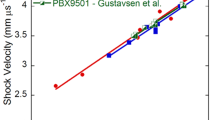Abstract
A nanometric HMX-based polymer-bonded explosive (PBX) is prepared by using the solution-water slurry technique. The resultant PBX is composed of 94% of HMX, 5% of fluororubber Viton, and 1% of wax. The properties of the nanometric HMX-based PBX, such as sensitivity and compressive performance, are comprehensively researched. The results show significant improvement for the nanometric HMX-based PBX as compared to the micron-sized HMX-based PBX. The friction sensitivity, impact sensitivity, and shock sensitivity of the nanometric HMX-based PBX are obviously lower by 30, 48, and 24%, respectively. Moreover, the compressive strength and strain of the nanometric HMX-based PBX are significantly higher by 273 and 33%, respectively. Thus, both the safety and mechanical resistibility of the PBX will significantly benefit from using nanometric HMX.
Similar content being viewed by others
References
Q. L. Yan, S. Zeman, and A. Elbeih, “Recent Advances in Thermal Analysis and Stability Evaluation of Insensitive Plastic Bonded Explosives (PBXs),” Thermochim. Acta 537, 1–12 (2012).
B. Nouguez, B. Mahe, and P. O. Vignaud, “Cast PBX Related Technologies for IM Shells and Warheads,” Sci. Technol. Energ. Mater. 70 (5–6), 135–139 (2009).
R. Menikoff, “Comparison of Constitutive Models for Plastic-Bonded Explosives,” Combust. Theory Model. 12 (1), 73–91 (2008).
M. Jaidann, H. Abou, X. Lafleur, et al., “Atomistic Studies of RDX and FOX-7-Based Plastic-Bonded Explosives: Molecular Dynamics Simulation,” Procedia Comp. Sci. 4, 1177–1185 (2011).
A. S. Kumar, V. B. Rao, R. K. Sinha, et al., “Evaluation of Plastic Bonded Explosive (PBX) Formulations Based on RDX, Aluminum, and HTPB for Underwater Applications,” Propell., Explos., Pyrotech. 35 (4), 359–364 (2010).
S. S. Samudre, U. R. Nair, G. M. Gore, et al., “Studies on an Improved Plastic Bonded Explosive (PBX) for Shaped Charges,” Propell., Explos., Pyrotech. 34 (2), 145–150 (2009).
W. Zhang, X. Z. Fan, H. J. Wei, et al., “Application of Nitramines Coated with Nitrocellulose in Minimum Signature Isocyanate-Cured Propellants,” Propell., Explos., Pyrotech. 33 (4), 279–285 (2008).
J. R. Luman, B. Wehrman, K. K. Kuo, et al., “Development and Characterization of High Performance Solid Propellants Containing Nano-Sized Energetic Ingredients,” Proc. Combust. Inst. 31 (2), 2089–2096 (2007).
R. S. Damse, A. Singh, and H. Singh, “High Energy Propellants for Advanced Gun Ammunition Based on RDX, GAP and TAGN Compositions,” Propell., Explos., Pyrotech. 32 (1), 52–60 (2007).
V. A. Strunin and L. I. Nikolaeva, “Combustion Mechanism of RDX and HMX and Possibilities of Controlling the Combustion Characteristics of Systems Based on Them,” Fiz. Goreniya Vzryva 49 (1), 62–73 (2013) [Combust., Expl., Shock Waves 49 (1), 53–63 (2013)].
E. Landsem, T. L. Jensen, F. K. Hansen, et al., “Neutral Polymeric Bonding Agents (NPBA) and Their use in Smokeless Composite Rocket Propellants Based on HMX-GAP-BuNENA,” Propell., Explos., Pyrotech. 37 (5), 581–591 (2012).
R. Dubey, P. Srivastava, I. P. S. Kapoor, et al., “Synthesis, Characterization and Catalytic Behavior of Cu Nanoparticles on the Thermal Decomposition of AP, HMX, NTO and Composite Solid Propellants, Part 83,” Thermochim. Acta 549, 102–109 (2012).
Q. L. Yan, X. J. Li, Y. Wang, et al., “Combustion Mechanism of Double-Base Propellant Containing Nitrogen Heterocyclic Nitroamines (I): The Effect of Heat and Mass Transfer to the Burning Characteristics,” Combust. Flame 156 (3), 633–641 (2009).
C. W. An, F. S. Li, J. Y. Wang, et al., “Surface Coating of Nitroamine Explosives and its Effects on the Performance of Composite Modified Double-Base Propellants,” J. Propul. Power 28 (2), 444–448 (2012).
X. L. Xing, F. Q. Zhao, S. N. Ma, et al., “Thermal Decomposition Behavior, Kinetics, and Thermal Hazard Evaluation of CMDB Propellant Containing CL-20 by Microcalorimetry,” J. Therm. Anal. Calorimetry 110 (3), 1451–1455 (2011).
C. N. Divekar, R. R. Sanghavi, U. R. Nair, et al., “Closed-Vessel and Thermal Studies on Triple-Base Gun Propellants Containing CL-20,” J. Propul. Power 26 (1), 120–124 (2010).
S. Y. Xu, F. Q. Zhao, J. H. Yi, et al., “Thermal Behavior and Non-Isothermal Decomposition Reaction Kinetics of Composite Modified Double Base Propellant Containing CL-20,” Acta Phys.-Chim. Sinica 24 (8), 1371–1377 (2008).
X. L. Song and F. S. Li, “Dependence of Particle Size and Size Distribution on Mechanical Sensitivity and Thermal Stability of Hexahydro-1, 3, 5-Trinitro-1, 3, 5-Triazine,” Defence Sci. J. 59 (1), 37–42 (2009).
X. L. Song, F. S. Li, J. L. Zhang, et al., “Influence of Particle Size, Morphology and Size Distribution on the Safety and Thermal Decomposition Properties of RDX,” J. Solid Rocket Technol. 31 (2), 168–172 (2008).
X. L. Song, Y. Wang, C. W. An, et al., “Dependence of Particle Morphology and Size on the Mechanical Sensitivity and Thermal Stability of Octahydro-1,3,5,7-Tetranitro-1,3,5,7-Tetrazocine,” J. Hazard. Mater. 159 (2-3), 222–229 (2008).
C. R. Siviour, M. J. Gifford, S. M. Walley, et al., “Particle Size Effects on the Mechanical Properties of a Polymer Bonded Explosive,” J. Mater. Sci. 39 (4), 1255–1258 (2004).
J. Liu, W. Jiang, F. S. Li, et al., “Preparation and Study on Nano Octahydro-1, 3, 5, 7-Tetranitro-1, 3, 5, 7-Tetrazocine,” Acta Armamentarii 34 (2), 174–180 (2013).
J. Liu, W. Jiang, F. S. Li, et al., “Effect of Drying Conditions on the Particle Size, Dispersion State, and Mechanical Sensitivities of Nano HMX,” Propell., Explos., Pyrotech. 39 (1), 30–39 (2014).
Author information
Authors and Affiliations
Corresponding author
Additional information
Original Russian Text © J. Liu, G. Hao, Yu. Rong, L. Xiao, W. Jiang, F. Li, Ch. Jing, H. Gao, T. Chen, and X. Ke.
Published in Fizika Goreniya i Vzryva, Vol. 53, No. 6, pp. 138–143, November–December, 2017.
Rights and permissions
About this article
Cite this article
Liu, J., Hao, G., Rong, Y. et al. Application and properties of nanometric HMX in PBX. Combust Explos Shock Waves 53, 744–749 (2017). https://doi.org/10.1134/S001050821706017X
Received:
Revised:
Published:
Issue Date:
DOI: https://doi.org/10.1134/S001050821706017X




